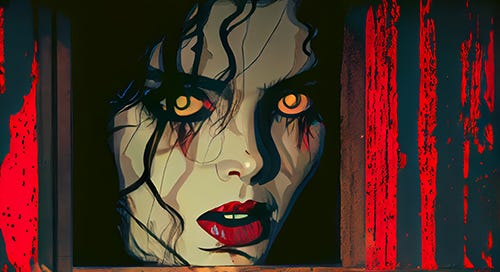As a genre, thrillers are crime movies using horror tropes. Let's also not ignore the fact that there a lot of horror films, especially some slashers, that have a mystery/investigation element to them. Thrillers and horror films use a lot of the same tools. I'm currently booked on a who-done-it of sorts and in the midst of planning.
Here's my 10 step "checklist" of what I have to do to write a mystery. If there's one genre that needs extra planning and plotting, this is it. There's things you need to know BEFORE you're even breaking your story.
"Like what?' you ask? LET'S DIVE IN:
KNOW YOUR CRIMINAL. Obviously, they will be the antagonist so you need to be in their head from the start, almost before your lead. Specifically, MOTIVATION is the key. Our justice system is based around motive. WHY they commit the crime is where you should start.
WHAT IS THE CRIME? Simply put-- is it a murder? A theft? Fraud? Some combination thereof? If your motive is sound, then from your criminal's POV this crime should have logic and reason (even if misguided or flawed) behind it. Or, in absence of those, a core emotional trigger.
IS THE CRIME PREMEDITATED? This is pretty key to your story. If you add up the first two items, it should give you the answer to this. This decision will generally effect the sort of story and subgenre you’re working in. It’s also possible that if the crime is serial, it could be a combination (more on this below).
WHAT’S THE PLAN? If the crime was premeditated, what was the criminal's plan? (This could be EXTREMELY detailed). If we're talking a complex heist or a murder with a frame-up, the criminal's plan would intricate and detailed. Note that these are the details your lead uncovers.
WHAT’S THE COVER-UP? If the crime was not pre-meditated, then your criminal is going to have to have a plan to not get caught. Similar to above, this exit-strategy is going to need a few steps (and maybe more bodies), and it’s what your lead will follow.
WHAT’S THE TIMELINE? Before plotting your story, write out a simple list that makes every beat of the crime clear. If you use all the info above and fill in the details, this timeline should cover everything. Somewhere in this timeline, a mistake is made. Either the criminal, or a minion, or even fate makes sure there is one bit of evidence left somewhere. Decide what this is, and note it in this timeline. I like to highlight these things, and other key moments, because these are going to be the CLUES your lead finds.
HOW DOES THIS TIMELINE OVERLAP WHAT’S ONSCREEN? You need to now decide where and WHEN your lead gets into this mess. Did everything already happen and your investigator getting the case is the start of the movie? Or is there more overlap where the criminal is only a step or two ahead?
HOW DOES THE CRIMINAL REACT TO THE LEAD? Now that somebody is on the hunt, does the criminal rest on their laurels, or commit more crimes in the act of trying to put more distance between them. A premeditated time could turn into a spur of the moment spree. You're also going to have to make some POV choices here. In a classic crime story, we likely know the villain and you have an A/B narrative. A whodunit though will hide the criminal amongst the cast and make their reveal into the story's final climax.
WHO KNOWS WHAT, WHEN? I like to chart this out once I know everything. If you have the crime timeline, and you know when the screen story begins on that timeline, you chart out when thelead, and other characters, have things revealed to them, That gets you a story spine.
BREAK THE STORY. Now that you have this spine, focus on the story of the lead. The investigation is likely the core plot, but as always, use the lead's relationship to the crime and discoveries to determine character arc. Knowing what has to be found out when, helps guide the path. Along the way. fill space with action beats, scenes built to raise questions , tension, red herrings, etc.
I don’t know how Agatha Christie or Arthur Conan Doyle, or the room for Pokerface does it— but this is how I do it. There’s lots of smaller decisions to make along the way, and you may need to do a full-on serial killer conspiracy theory notecard wall to track it.
No doubt about it— this is one of the hardest types of stories to break, but when you do, it feels pretty awesome.
Below is a scary looking PDF of the list above for downloading and printing:




